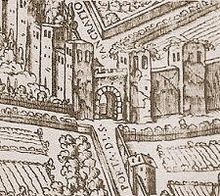Porta Aurelia
The Porta Aurelia was one of only three city gates on the western bank of the Tiber in ancient Rome . It stood on the southern edge of the Gianicolo hill .
The gate was part of the Aurelian Wall , which was built between 271 and 275 AD. The Via Aurelia ran through the gate and led to Pisa and from there to Gaul . The road began at the Forum Boarium south of the Marcellus Theater , crossed the Pons Aemilius , led through the 14th region and left the city at the Porta Aurelia.
On an ancient map of Rome, the Porta Aurelia is shown with a single passage, flanked by two square towers. There is no reliable evidence of the actual appearance.
In front of the porta - as well as in front of the other city gates of Rome - numerous tombs and underground catacombs were built in accordance with Roman burial custom on both sides of the arterial road . The young martyr Pankratius was buried in one of these catacombs, and a basilica was built over his grave a little later . Since this popular saint attracted large crowds of pilgrims , the gate has also been called Porta San Pancrazio since the 6th century .
Pope Urban VIII had a new city wall built in the area of the Janiculum in the first half of the 17th century. The Porta Aurelia was in such poor condition that it was demolished in the course of this work in 1644 and replaced by the new Porta San Pancrazio .
But this successor building did not survive either, as it was destroyed by French bombardment in 1849 during Giuseppe Garibaldi's freedom struggles . The current gate is a reconstruction from 1854.
literature
- Filippo Coarelli : Rome. An archaeological guide. Herder, Freiburg (Breisgau) et al. 1981, ISBN 3-451-17247-X , p. 25. 32.
- Samuel Ball Platner , Thomas Ashby : A Topographical Dictionary of Ancient Rome. Oxford University Press, London 1929, p. 404 ( online ).
- Lawrence Richardson Jr .: A New Topographical Dictionary of Ancient Rome. Johns Hopkins University Press, Baltimore MD et al. 1992, ISBN 0-8018-4300-6 , p. 300.
Coordinates: 41 ° 53 ′ 18.3 " N , 12 ° 27 ′ 41.3" E

